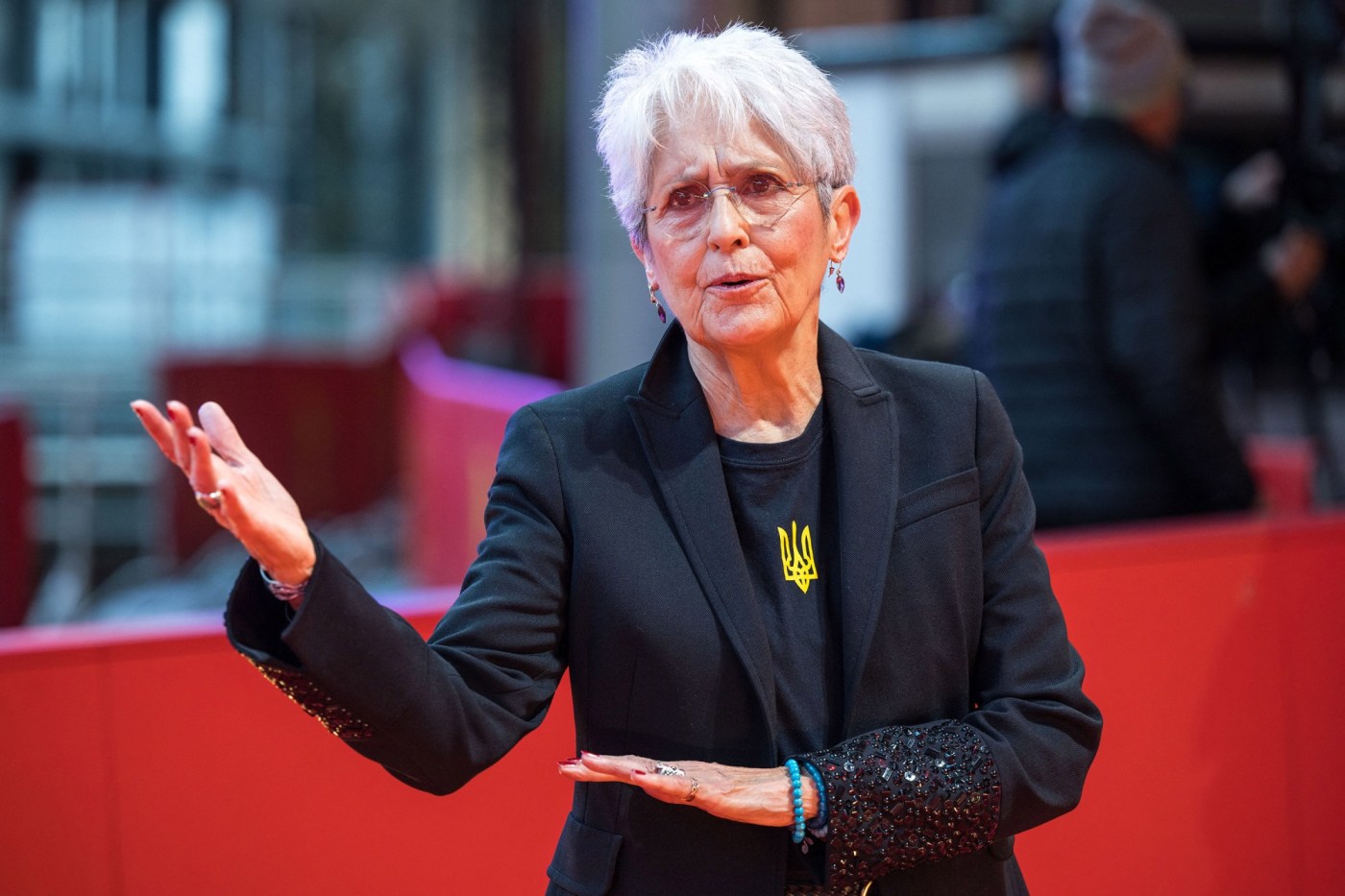
Joan Baez said she wanted a ‘warts and all’ film about her life. She got one
At the start of the new documentary, “Joan Baez I Am A Noise,” there’s a quote from the writer Gabriel García Márquez that fills the screen for a moment: “Everyone has three lives: the public, the private, and the secret.”
It’s a signal that this film has stories to share about the 82-year-old folk singer and political activist that have never before been told.
That wasn’t the original intent, Baez says with a wry smile on a recent video call.
“It was going to be about the last tour,” Baez says of a run of 2018 farewell shows. “Then at a certain point, I realized I had to let them in farther than just that.
“I literally handed them the key, the three directors, to the storage unit,” she says. “In the film, when I walk into it, that’s the first time I I’ve ever been in there.”
With that key, co-directors Karen O’Conner, Miri Navasky, and Maeve O’Boyle entered a chamber of treasures that Baez had forgotten existed.
“I knew that my mom had kept some stuff,” Baez says. “In the back of my head, I knew that. I didn’t know that she kept everything. All of my father’s footage from moving pictures and stills. Every drawing from when I was five on. So we dipped into all of that and used that to make the film cohesive.”
The home movies show Baez, the middle child between sisters Pauline and Mimi, traveling the world on trips her parents took them on. The drawings are used beautifully in the film, her original work getting animated to illustrate different moments.
And there’s more: Diaries and letters and audio tapes that Baez recorded to send home from her travels.
“It’s different having a 21-year-old say to the mom, ‘I’m going to march tomorrow with probably 40,000 people and it’ll be with Dr. [Martin Luther] King,’” Baez says about how the audio letters gave voice to her thoughts as they were then. “Here’s this 21-year-old whose mind is blown by all this going on, instead of me retelling the tale.”
O’Conner was a longtime friend before she, Navasky and O’Boyle directed the film, and Baez gave the trio free rein to use what they wanted and tell her story as they saw fit.
“I signed on for this, so there was nothing I could do about it,” Baez says, laughing. “They did the film. I wanted to leave an honest legacy, and I was serious about it. So it’s warts and all.”
What about Bob?
Much of Baez’s public life is well known.
At 19, she exploded onto the folk music scene and quickly escaped the confines of genre to become one of the best-known singers of the ’60s. She was with Martin Luther King Jr. at the March on Washington and at countless protests against the Vietnam War. She’s in the Rock & Roll Hall of Fame, a Grammy winner, a Kennedy Center honoree.
As well, her private life at times broke into the public realm.
Baez’s romance with the then-little-known singer-songwriter Bob Dylan united the two biggest stars in folk in the early ’60s for a time. Her marriage to the anti-war activist David Harris produced her only child, Gabriel Harris, while David was in prison for refusing to report to the military after he was drafted.
The ramifications of both of those relationships are explored in much greater depth in “I Am A Noise.”
Her relationship with Dylan started out like a fairy tale, and the film includes footage that makes their love for each other clear, including one special clip of the two singing Dylan’s “It Ain’t Me, Babe,” when she was already a star, and he still needed to be introduced when he joined her on stage.
“That’s one of my favorite parts of the film,” Baez says. “It was so happy and so innocent.
“I was already established, but as a ballad singer,” she says. “I didn’t write for years. So here we are bouncing around upstate New York, and it was really, really fun.”
Fun turned to sorrow in 1965 when on the trip to England that was filmed for the Dylan documentary “Don’t Look Back,” Dylan casually dismissed the significance of their relationship, essentially ghosting Baez even as she occupied the same room as him. Baez admits in “I Am A Noise” that the relationship was both her greatest love and her worst heartbreak.
“It would be different if I hadn’t had a come to Jesus moment about five or six years ago,” she says of finally reaching a place of peace in how she views her time with Dylan. “I was painting him as a young man, probably a 21-year-old, and I put his music on and I started to cry.
“And everything, all of the animosity, whatever (stuff), just vanished,” Baez says. “It just drifted off me and it’s stayed that way. So that’s a different answer than you would have gotten off me 10 years ago. I was still struggling.
“I mean, I still make jokes about him because he’s nuts,” she says, laughing. “But that’s different from holding a lot of resentment.”
Seeing herself
Baez first watched the film as a rough cut, but has since seen it many times at film festivals and screenings. The journey it takes through her life has been revealing in many ways, she says.
“Part of it was an education,” she says. “Seeing my sisters, for instance, say what it was really like, how I really had affected their lives (with early fame and stardom). I mean, I kind of knew it, but because they knew Karen and trusted her, my older sister, who would never get in front of a camera, was willing to say her truth.
“And then Mimi to say hers,” Baez says of her younger sister, who as Mimi Farina was also a well-known folk singer though never the star that Baez became. “That for me was surprising. I’m grateful for all of it.”
Baez and her son for years had a difficult relationship. She was drawn to the road for concerts and protests, and Gabriel grew up feeling the distance between him and his mother, as the film explains.
“My son, I knew pretty much about what had gone on between us,” she says of Gabriel, who appears in the film both as a member of her 2018 band and in archival footage. “He was so forgiving and so eloquent, talking to Karen also. So I learned the extent of his abandonment issues when he was little.”
Other moments bring nothing but joy, she said. Seeing footage of her first trip to France and the red carpets and photo shoots she was part of was fun.
“And the women backstage in Selma, Alabama, after the end of the concert,” Baez says of a moment in 2018 when several women approached her and thanked her for her civil rights activism. “They were just standing in front of the theater, and I went over to talk with them. That was so beautiful.”
Still, at different moments, other more difficult parts of the film might surface for her, Baez says, forcing her to consider anew the history, visible or hidden, of her life.
“I’m still reacting to new things when I see it,” she says. “There are a couple of things that I’d prefer that they weren’t there. And then I look at it. I think this is part of what knitted this whole thing together, so in the end, I am just delighted with this film.”
Secrets and memories
Early on the film foreshadows the secret life it will reveal. As a young singer, Baez wrote in her diaries and letters about a darkness that came for her at times, delivering panic attacks and depression.
Closer to the end, its source is revealed as Baez talks about the intensive therapy sessions she and her sister Mimi separately started more than 30 years ago, which eventually led them to believe their parents had been sexually inappropriate or abusive to them as children.
The film uses letters between Baez and her parents, and audio tapes from eight years of therapy which the filmmakers pulled from her storage locker, as well as drawings Baez made while in therapy and her own more recent interviews.
“I didn’t learn much from that part of the film because I lived it so fully going through it,” she says. “Nor have I ever listened to those tapes. It’s insane to tell somebody to go ahead and listen to eight years of therapy tapes, but we did.
“I think the answer to that question is I have felt so complete since completing that work,” she says of what has come from mining her memories. “There is one scene in the film, not that it wasn’t true, because it was, but right now it’s very different. That was the scene in Istanbul when I’m having like a mild version of a panic attack, and it’s not representative of me now.”
In a way, the film is a testament to the act of remembrance, and how even in places where solid proof is absent, memories can be true to those who hold them.
“It clearly comes up throughout the film about memory,” Baez says. “Which is why I say even in the film, I can’t prove anything, say, about the dramatic stuff. And all of us, or anybody who writes about their past is going to have their own version of it. I mean, I’ve seen somebody fight about the most petty things. ‘No, I know that dress was blue’ – ‘Uh-uh, I thought it was red.’
“You resist, but those are your distinct memories,” she says. “And so, keeping that in mind, it was a journey through memories, after biting off, you know, what I needed to bite off to get started.
“Those were memories in one way or another that freed me from the darkness of my past.”


